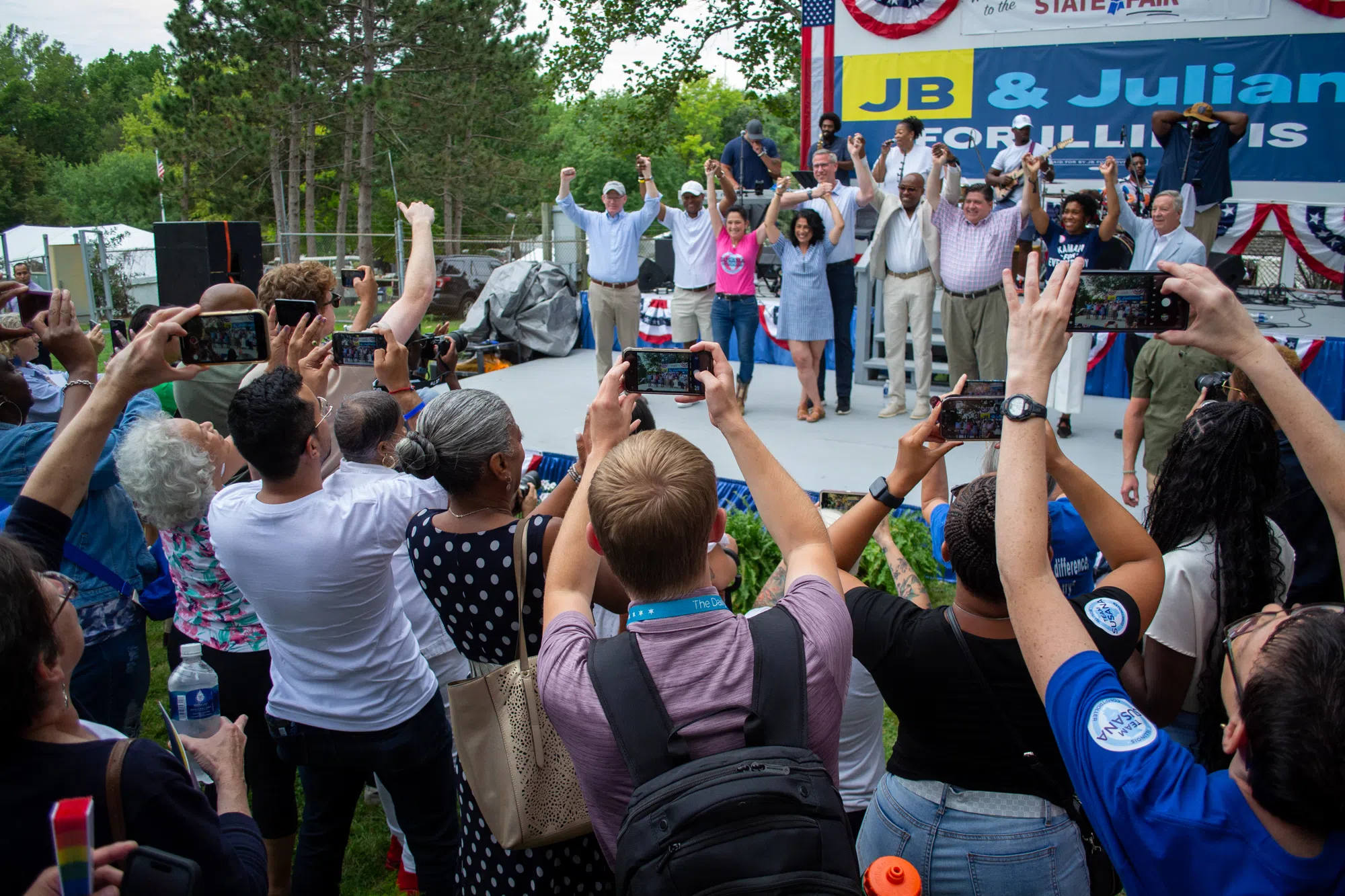Governor’s Day at State Fair draws party faithful from across the state
By PETER HANCOCK
& HANNAH MEISEL
Capitol News Illinois
news@capitolnewsillinois.com
SPRINGFIELD – Democrats gathered in Springfield Wednesday for their annual rally at the Illinois State Fair amid a surge of enthusiasm and a renewed sense of optimism about their chances of retaining the White House in November.
“There’s a new level of energy in this effort,” U.S. Sen. Dick Durbin told reporters just before the traditional Democratic County Chairs’ Association fundraising brunch Wednesday morning. “You can’t buy it. You can’t fake it. It’s for real.”
That renewed sense of excitement has come about just in the last few weeks. On July 21, following a disastrous debate performance that raised doubts about his ability to serve another term, President Joe Biden withdrew from the race and endorsed Vice President Kamala Harris to run in his place.
Harris, whose own short-lived campaign in 2020 ended before the first primary ballots were cast, quickly consolidated support from party leaders and donors, as well as delegates to the Democratic National Convention.
Now, just days ahead of the DNC in Chicago, the most recent New York Times poll shows her in a statistical dead heat with her Republican rival, former President Donald Trump, and enjoying a razor-thin advantage in the key battleground states of Wisconsin, Michigan and Pennsylvania.
That marks a dramatic change in fortune since Biden’s withdrawal just 3 ½ weeks earlier, when the New York Times’ average of national polls showed the incumbent trailing Trump by 3 points.
“Right person at the right time in a historic election,” Durbin said of the sudden shift. “That’s it.”
Illinois House Speaker Emanuel “Chris” Welch said he has seen the change in enthusiasm as well, and expressed hope that it will reach into down-ballot races, enabling Democrats to expand their already-existing super majority in the General Assembly.
“I saw something similar in polling in ’22 after the Dobbs decision came down,” he said, referring to the U.S. Supreme Court ruling that overturned Roe v. Wade and declared there is no constitutional right to an abortion. “But this seems to be even more of a bounce, and we’re not even at the convention yet, so I expect it to continue.”
Harris is now only the second woman, after Hillary Clinton, and the first woman of color to win a major party nomination for president. But she is not the first woman of color to seek the nomination. That distinction belongs to the late U.S. Rep. Shirley Chisholm, D-New York, who ran unsuccessfully for the Democratic nomination in 1972.
In a recent New York Times interview, Illinois Attorney General Kwame Raoul reflected on that race and how Chisholm encountered an unexpected obstacle in her campaign – a lack of support among Black men who were reluctant to award power to a Black woman.
Raoul said he is now working to prevent that from happening again as Harris campaigns for the presidency. And in an interview at the State Fair Wednesday, he said he thinks significant progress has been made since 1972.
“I don’t think we’re perfect yet, but I think we’ve made progress,” he said.
“Obviously, I used my voice to speak to it because I think it still lingers as a challenge,” he said. “I think predominantly, she (Harris) will have support of African American men, not because of her color, but because of her experience and her position on the issues that disproportionately affect African American men.”
Mentioned a few times during Wednesday’s programming was Raoul’s predecessor in the Illinois Senate, former President Barack Obama – whom keynote speaker Cincinatti Mayor Aftab Pureval credited with his entrance into politics. He gave credit to Obama for “inspiring a new generation of leaders.”
The 41-year-old is the only Asian American mayor of a big Midwest city and is among a small class of Asian American mayors in the U.S., according to research from the Asian Pacific American Institute for Congressional Studies. Pureval joked that his father could’ve chosen any American city when emigrating from India, but chose to relocate his family to Beavercreek, Ohio, where the future mayor grew up.
“And thank God we did, because that is the path to victory for Vice President Harris,” Pureval said of Asian immigrants who also chose to make the Midwest their home.
“The whole damn family is lactose intolerant. Let’s go to the cheese capital of the world,” he continued, with laughter from the crowd. “That’s the Midwest Asians that I’m talking about.”
Pureval acknowledged that Harris, who is both Black and Indian, will endure “racist tropes” from Republicans during the campaign’s sprint to Nov. 5; Trump has already called the vice president’s ethnicity into question, claiming at a recent rally that Harris “turned Black” for political gain.
But he said his own experience embracing his heritage and refusing to Anglicize his name — despite well-meaning advice from other Democrats — has taught him that voters are more accepting than conventional political wisdom would indicate, so long as candidates can communicate a vision and follow through with action.
“There are people who say that this country’s not ready to elect a Black, Indian, female president. And they’re wrong,” he said. “I believe in this country. I believe in its promise…And I believe in that because of my own story.”
Pureval’s mother, he said, fled Tibet when China’s communist regime took over the country in the 1950s. And “in one generation,” Pureval said, his family “went from being refugees” to seeing him elected mayor of Cincinnati.
“And Democrats, that story only happens in this country,” he said. “It’s on us to preserve that dream for the next generation. Let’s go win this thing.”
Cincinnati, the third-largest city in Ohio, is part of the so-called “Rust Belt” Democrats are trying to regain their footing in after losing so many predominantly white, rural counties to Trump in 2016.
In order to win critical swing states like Wisconsin, Michigan and Pennsylvania, home to many of the hollowed-out factory towns that characterize the Rust Belt, Democrats have leaned heavily on organized labor to push for and tout Biden’s signature infrastructure plan to voters whose cities and towns have steadily lost population — and investment — in the last half-century.
But Pam Davidson, Democratic State Central Committee member and chair of the local Democratic Party in western Illinois’ Knox County, told the hundreds gathered at Wednesday’s breakfast that Democrats can turn even one of the party’s most vulnerable issues — the Biden administration’s handling of migrants at the southern U.S. Border — into an opportunity for a more appealing message.
“Republicans talk about the border. They talk about people wanting to come over across for better jobs…for a better life. They said it’s too many,” Davidson said ahead of accepting a “Party Builder” award from the IDCCA.
“They talk about it all the time but they don’t talk a damn thing about our jobs, big businesses sending jobs over to Mexico and paying them only $3 an hour and no benefits,” she continued. “And our people — our union jobs — were laid off. They don’t talk about that.”
Davidson’s hometown of Galesburg was for decades the home of a Maytag factory, but nearly 20 years ago the plant closed and the company moved the bulk of the manufacturing to Mexico and Korea, leaving roughly 1,600 unionized workers out of a job. The facility sat empty until 2020, when an agriscience business moved in.
She said Harris would understand that businesses who move jobs overseas “need to be taxed for what they do.”
Capitol News Illinois is a nonprofit, nonpartisan news service covering state government. It is distributed to hundreds of newspapers, radio and TV stations statewide. It is funded primarily by the Illinois Press Foundation and the Robert R. McCormick Foundation, along with major contributions from the Illinois Broadcasters Foundation and Southern Illinois Editorial Association


